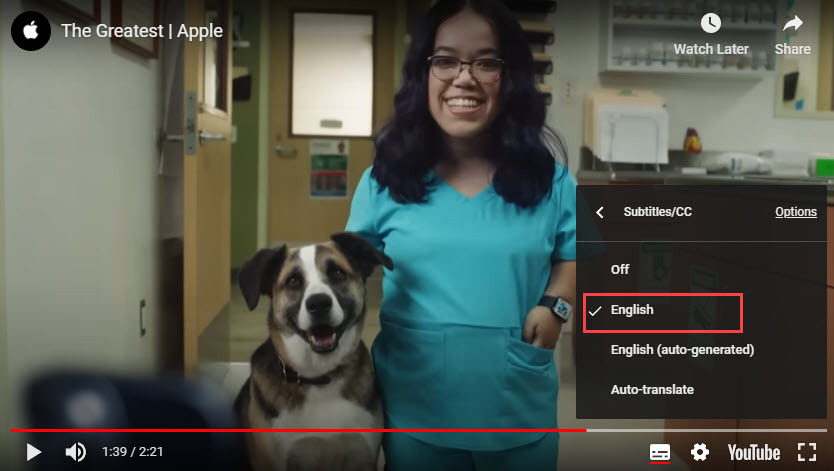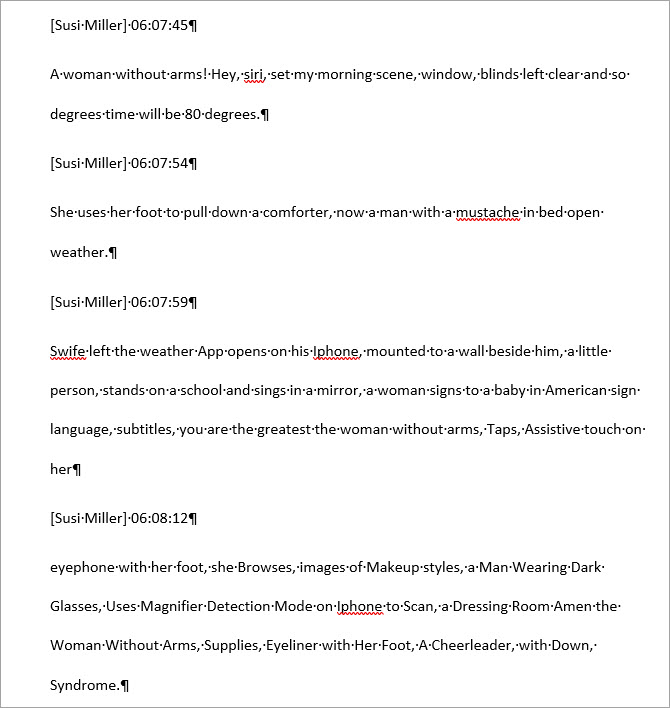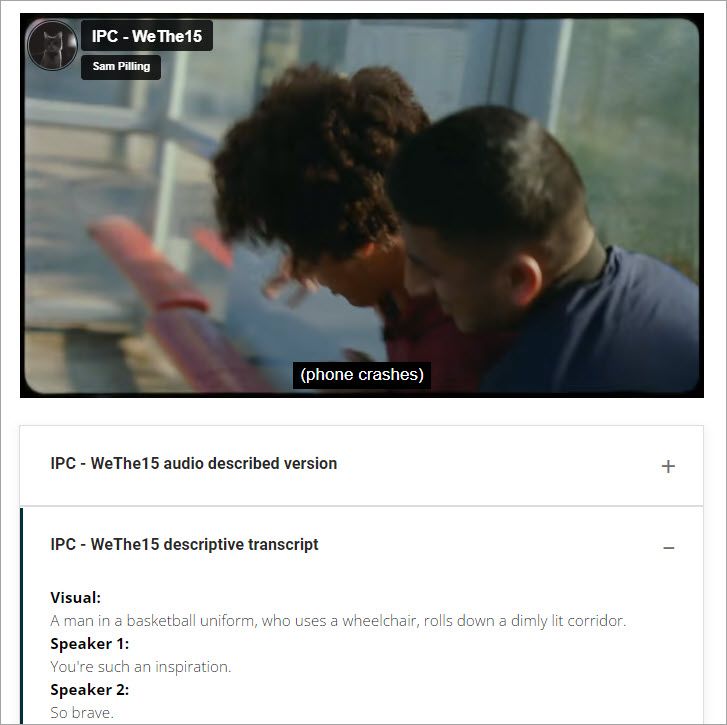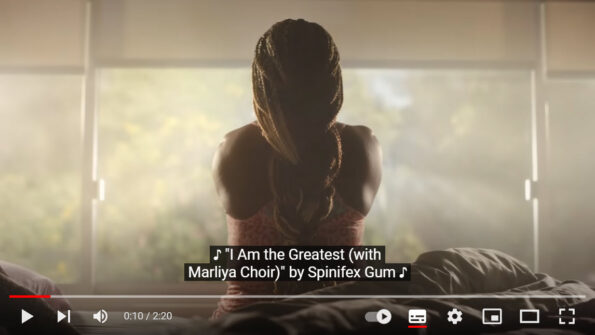To celebrate International Day of Persons with Disabilities 2022 (Note: All links in this article open in a new tab) Apple released their new showcase video of assistive technology features. At eLaHub we wanted to share this video on social media with the message that every L&D practitioner who is taking even one ‘micro commitment’ to making their learning content accessible is helping to empower the 1.3 billion people with disabilities worldwide to learn and to achieve their potential.
Just as with all the videos we use in our learning content, we also wanted to make sure that everyone had equal access to the video we posted. But this reminded us that it isn’t always easy to know how to make our video content both accessible to standards and a welcoming and inclusive experience for all of our learners. So we decided to use the Apple video to show how it can be done. In the eLearning auditing work we do at eLaHub, video content is definitely the area where we identify most confusion and the most violations of the Web Content Accessibility Guidelines (WCAG). So what do we have to do to make sure that our video content is accessible and inclusive? Here are some key requirements to be aware of – it’s not a comprehensive list, but it covers some of the main points we so often see causing issues.
1. Captions
For learners who are deaf or hard of hearing, providing captions is a must. But many people aren’t aware that to provide an equivalent experience, and to meet WCAG standard 1.2.2 Captions (Prerecorded) – Level A these captions must be:
- Synchronised
- Descriptive (i.e. describe any sound effects or emotions conveyed in speech etc.)
- Accurate.
This means that if you are using an external video from a video platform, you need to make sure that the captions in the video haven’t been auto-generated. If they have, they will not have the descriptive details they might need, contain a lot of mistakes and have no punctuation. An easy way to check this is to select the Settings (cog) icon and check the options. If the only option that you have is the auto-generated version, this won’t be accurate enough to give your learners an equivalent experience, or to pass the WCAG standard. Inaccurate captions are one of the most common fail issues we identify in audits.
If you are hosting your own videos on YouTube you can Add subtitles and captions yourself. If the videos are from an external organisation and don’t have accurate captions, we would definitely recommend looking for other videos. But if that isn’t an option, in the spirit of ‘progress over perfection’ your only option might be to consider providing a text version of the captions and detailing this in a course level accessibility statement. Although this wouldn’t pass the WCAG standard it would at least give learners who were deaf or hard of hearing some kind of access to the video content.
Caption options in YouTube

The settings in the YouTube video player show that this video has captions which have been edited. If the only option available is the auto-generated version, the captions will not be helpful to your learners.
2. Audio description
If the video you are using in your learning content contains important visual information which someone who is blind or has low vision will not be able to see, you need to provide audio description. This is best practice and meets WCAG standard 1.2.5 Audio Description (Prerecorded) – Level AA. If you are a visual developer the easiest way to check if a video needs audio description is to watch it through, and then play it again without looking at the screen. If you do not have an equivalent experience i.e. miss important content which adds to the meaning of the video, this is an indication that you need to provide audio description. Many organisations aren’t aware that they must provide audio description for videos with important visual information if they need to meet WCAG AA compliance. Providing a transcript which gives the visual details in text, doesn’t meet this standard.
Many organisations aren’t aware that to meet WCAG Level AA compliance, they must provide audio description for videos with important visual information.
In some cases you may find that a video has an audio described version. This is the case with Apple’s The Greatest video.
The Greatest with audio description
If you create videos within your organisation you can create an audio described version, or work with a third party supplier to provide this for you. For some organisations this may pose logistical or resource problems. If this is the case, again in the spirit of ‘progress over perfection’ at eLaHub we recommend providing a text version of the audio description and detailing this in a course level accessibility statement.
3. Descriptive transcript
Even if you provide audio description, eLaHub always recommend making sure that all your learners also have access to a transcript which describes all of the important visual details. This meets the advanced WCAG standard 1.2.8 Media Alternative (Prerecorded) – Level AAA. It’s also considered best practice for accessibility experts for lots of other reasons.
- It aligns with Universal Design for Learning Principals (UDL) particularly providing multiple means of representation and gives learners choices about how they access video content.
- It includes learners with cognitive access needs who might find it easier to process text rather than moving mages in video.
- It benefits learners who rely on captions but might find it difficult to follow them if they are fast because they are synchronised with the action in the video.
- As very powerfully pointed out by deafblind lawyer and disability advocate Haben Girma, text transcripts are the only way that some learners who are deafblind and use braille displays can access video content.
But what happens if you don’t have a descriptive transcript? Again you can work with third party suppliers – or you can easily create one yourself. A trick we use at eLaHub is to make a start using the automatic captioning functionality in the Zoom platform. We open up the video webpage, start Zoom and activate the Share Screen functionality making sure that we have ticked the Share sound option when we share the screen. We then enable the Show captions functionality and select the View Full Transcript option. Finally we play the video and save the transcript. This still needs quite a lot of editing work, but it probably cuts down the amount of time we need to spend creating text transcripts by about half.
Zoom generated full transcript

Transcript created using the automatic captioning facility in Zoom. It still needs a lot of work to make it accurate and to add the important visual details, but is so much quicker than starting from scratch.
The Greatest descriptive transcript
Visual: A woman without arms waking in her bed speaks to Siri.
Woman: Hey, Siri, set my morning scene.
Visual: Window blinds lift.
Siri: It’s currently clear and 71 degrees. Today’s high will be 80 degrees.
Visual: She uses her foot to pull down a comforter. Now a man with a moustache lying in bed.
Man: Open weather. Swipe left.
Visual: The Weather App opens on his iPhone mounted to a wall beside him. A little person stands on a stool and sings in a mirror. A woman signs to a baby in American Sign Language.
Song subtitles: You are the greatest.
Visual: The woman without arms taps Assistive Touch on her iPhone with her foot. She browses images of makeup styles.
iPhone VoiceOver: Describe images.
Visual: A man wearing dark glasses uses Magnifier Detection mode on iPhone to scan, a dressing room.
iPhone VoiceOver: A painting. A red jacket.
Visual: The woman without arms applies eyeliner with her foot. A cheerleader, with Down Syndrome high fives a student. A DJ wearing a nasal cannula hovers his cursor, over a Track and Logic Pro. It magnifies with Zoom. On iPad the cheerleader taps the Speak Screen menu, then taps a Muhammad Ali quote.
iPad: “I have wrestled with the alligator, tussled with the whale.”
Visual: The DJ rides a scooter as Maps Directions appear on his Apple watch. The man with the moustache poses.
Man: Tap, take picture. Tap, take picture
Visual: Using voice control, he takes pictures of himself modelling in a power wheelchair. The man in dark glasses uses door detection on his iPhone.
iPhone: 2 doors detected. Text. To stage. Door four feet away.
Visual: Using a white cane he walks toward a door that reads “Stage.” The woman steers a car with her foot and sings. Tears fill the baby’s eyes. Their mother, looks at her apple watch which displays a sound recognition alert that reads “Baby crying.” The man with dark glasses plays piano on a stage. Spotlights shine on him and blur the audience. The mother scoops up her crying baby. The woman without arms takes a selfie with friends. The little person flicks her hair. Now in scrubs at work, she takes a timed selfie with a dog, using iPhone and Camera Remote on her Apple watch. The cheerleader takes a selfie with a friend. At a party, the DJ claps as his song plays on MacBook. The woman increases the volume in her car with her foot and she shakes her shoulders. On MacBook, the model sorts through photos using facial expressions within alternate pointer controls. He selects a photo, then scrunches his nose and raises his eyebrows to crop it. On iPad, the cheerleader taps a quote by Muhammad Ali.
iPad: “I shook the world.”
Visual: The mother signs “I shook the world” in American Sign Language, while her baby sleeps in her arms.
Visual: The Apple logo appears.
In practice
But how can we practically apply this in our learning content? This is an example of how we make video content accessible and inclusive at eLaHub using the Rise Articulate 360 Authoring tool.

We find the Rise accessible accordion block hugely helpful in allowing us to provide our learners with different ways to access video content without overcrowding the learning.
For eLaHub, making sure that we provide all of our learners with as near as possible an equivalent experience and equal access to video content is one of the most important ways that we make your learning resources not only accessible, but also welcoming and inclusive. We hope that you find these tips helpful. And if you’re thinking of sharing the Apple video or using it in your learning content, please feel free to copy and share the descriptive transcript to include as many people as possible.
Ready to start your eLearning accessibility journey?
Next available course dates for our CPD accredited eLearning accessibility for Articulate 360 programme:
March 2023
eLearning accessibility fundamentals for Articulate 360 – Wednesday 15/03/23 – 1.00pm – 4.30pm BST
eLearning accessibility further steps for Articulate 360 – Wednesday 29/03/23 – 1.00pm – 4.30pm BST




Recent Comments